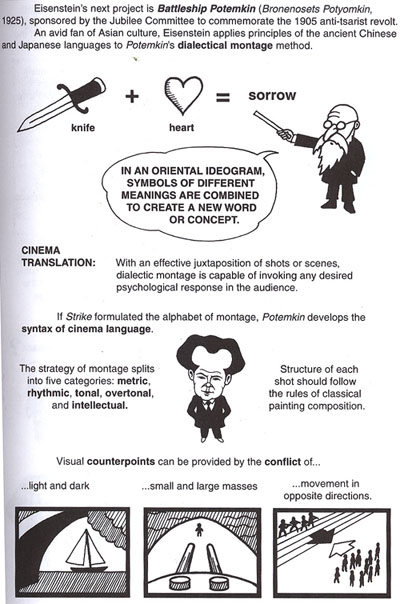Lifelong Learning Institute: SILENTS,
PLEASE: Spring 2004
Sergei Eisenstein (1898-1948) Selected
Filmography:
|
YEAR
|
FILM: as director
|
|
1924
|
STRIKE
|
|
1925
|
BATTLESHIP POTEMKIN
|
|
1928
|
OCTOBER: TEN DAYS THAT SHOOK THE
WORLD
|
|
1929
|
THE GENERAL LINE
|
|
1929
|
STURM UBER LA SARRAZ
|
|
1930
|
ROMANCE SENTIMENTALE
|
|
1937
|
BEZHIN MEADOW
|
|
1938
|
ALEXANDER NEVSKY
|
|
1939
|
FERGHANA CANAL
|
|
1943
|
IVAN THE TERRIBLE, PART
I
|
|
1947
|
IVAN THE TERRIBLE, PART
II
|
|
1979
|
QUE VIVA MEXICO
|
Russian Cinema and montage as mode of
expression:
- montage: French term for editing: literal
meaning: "to assemble"
Lev Kuleshov: approach to montage: 1st
theorist of Soviet cinema: experiments:
- juxtaposing the face of an actor and other
images: revealed the impact of montage
- approach to editing: emphasizes dynamic
discontinuous relationships:
- between shots and the juxtaposition of
images:
- creates ideas not present in
either one by itself
- editing constructs meaning: thesis +
antithesis = synthesis
Eisentein: studied the films of D.W.
Griffith and Kuleshov's montage experiments
- convinced that in cinema one could
manipulate time and space:
- creating new meanings for
images
- built new cinematic grammar: montage of
conflicting shots:
- goal: persuading the viewer towards a
certain POV: dialectical montage
Eisentein’s dialectical
montage:
- action broken up as a series of clashing
shots
- no tracking shots used to convey
movement
- kineticism: jagged intense movement within
the frame
- functions as a film metaphor:
- where 2 shots are put together to
suggest a comparison
From The History of Cinema for Beginners by Jarek
Kupsc:

Scenes from POTEMKIN
bgs: 03-04

